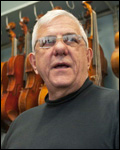2001
AL#65 p.10 BRB6 p.82
Paul Schuback
 Schuback learned violin making in a small shop in France during the ’60s. This segment of his 1995 convention workshop lecture covers completing the plates and fitting the neck, fingerboard, nut, and soundpost to the body. There’s lots of local French color, old tools, and old ways presented here, as well as a bit of how the violin has changed since the days of the first Italian masters. Part One appeared in AL#63. With 33 photos, a diagram, and a sequence chart for building a violin.
Schuback learned violin making in a small shop in France during the ’60s. This segment of his 1995 convention workshop lecture covers completing the plates and fitting the neck, fingerboard, nut, and soundpost to the body. There’s lots of local French color, old tools, and old ways presented here, as well as a bit of how the violin has changed since the days of the first Italian masters. Part One appeared in AL#63. With 33 photos, a diagram, and a sequence chart for building a violin.
This article has been nominated as one of the Guild’s fifty best articles published before 2010.


